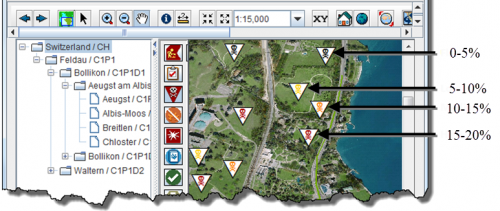Setting-up Maps and Coordinate Systems
IMSMANG includes an embedded GIS based on ESRI’s ArcGIS 9.x that allows users to visualize mine action information on an integrated map without moving to another application. While IMSMANG implements many standard GIS features, information managers can augment the provided capabilities with external GIS applications such as ArcGIS Desktop. Since these customisations can have an impact on the performance and usability of the system, it is important to consider the necessary map and GIS customisations for IMSMANG prior to beginning widespread use of the system.
Map Background
IMSMANG is designed to support a variety of users from information managers to operations users. Recognizing that each user or group of users may require a different set of maps, IMSMANG allows users to visualise data on maps individually tailored for their needs. For example, users in a regional mine action programme office may need only maps of their region to display data while MRE coordinators may need only vector map layers to visualise MRE data.
Using ESRI’s ArcGIS Desktop products, programmes can create custom .MXD files (or ArcMap-formatted maps) for each client, allowing users to visualize common data on different maps. Customisations of.MXD files can include adding and modifying raster and vector layers, label display, scale management and many other GIS functions.
Following the guidelines below, information managers can build easy-to-use, sustainable maps for visualising data in IMSMANG:
| Guidelines for Designing Map Backgrounds | |
| Guideline | Explanation |
| Use only the layers you need | When creating or customising maps, include only the layers necessary for map visualisation. Extra layers take up space and present users with unnecessary, confusing options. Consider tailoring specific maps for each user group, for example, building one map for MRE users and a separate map for operations staff. |
| Limit raster layers | Raster images take up a large amount of space compared to vector layers, causing slower system performance. Limiting the use of raster layers to one or two background images or turning them off by default can improve performance of the map display and IMSMANG overall. |
| Tile maps | Breaking up a map into multiple images, or tiling them, allows users to turn individual sections on and off as needed, which results in improved performance. |
| Back up the .MXD files | Keep backups of map(s) in their state prior to importing them into IMSMANG. This makes later map customisation easier and speeds up the process of importing the maps again. |
| How To |
|---|
Map Themes and Symbology
IMSMANG comes with several symbology options for displaying mine action data on the map. For example, hazards can be displayed on the map with different symbols for priority, status and type. These symbols are stored in the .MXD file and can be customised by information managers as desired. Additionally, IMSMANG allows information managers to create subthemes for each item. Using the Subtheme manager, information managers can display the different attributes of any item that are collected using single-select option lists on field report templates. For example, information managers can display the different symbols for the “Slope” values of hazards including “High,” “Medium,” “Low” and “Flat.” The example is shown in the figure below.
Example of Displaying Different Symbols for Different Attributes
Changing the symbology used to display data in IMSMANG is a multistep process (as shown in the figure below) that should only be undertaken by advanced users with an understanding of GIS. Further, as with all map customisation activities, this process requires the use of ArcGIS Desktop products.
Process for Changing IMSMANG Map Symbology
Projection and Coordinate Systems
All geospatial data in IMSMANG is stored in LLWGS84 decimal degree format, but IMSMANG can display data in virtually any coordinate system. IMSMANG comes with all the coordinate systems available to ArcGIS Desktop products like LLWGS84 and MGRS, yet information managers can add other systems their programmes use including UTM and national coordinate systems. Using the Coordinate System manager, information managers can add coordinate system and projection (or .PRJ) files to IMSMANG and establish a set of relevant systems that can be used for coordinate data entry and visualisation.
| How To |
|---|
In addition to customised coordinate systems and projections, IMSMANG supports the use of localised number formats for coordinate entry, for example 73.233 or 73,233. IMSMANG validates all numeric coordinate data based on the client’s locale settings so users running in a locale that uses a comma as a decimal separator can enter 72,333 while users running in a locale where a period is the decimal separator can enter 72.233.
| |
To add, change, or remove coordinate systems, you must have the Reference System Manager permission |
The coordinate systems displayed in IMSMA are managed using the Coordinate System List window. The available coordinate systems are from ESRI. IMSMA does not support custom coordinate systems at this time.
Access the Coordinate System List window from the Map menu and select Coordinate System. The Coordinate System List window displays.
Coordinate System List Window

